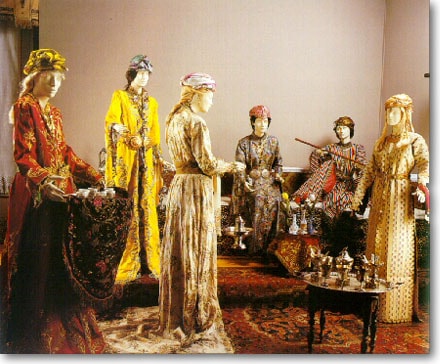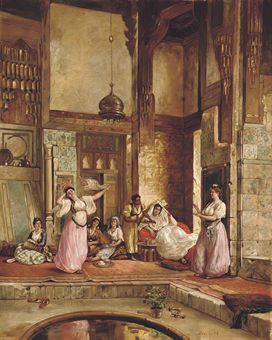anatolian treasures
12 Ağustos 2013 Pazartesi
Sultan's Clothes
The collection of sultans’ clothing, which showcases perhaps the finest examples of Ottoman textile art, contains clothing of the sultans and princes from the second half of the 15th century to the early 20th century.



The decorative patterns of the sultans’ clothing were drawn up by palace miniaturists, who made up a large part of the court’s artists and artisans working for the court, or ehl-i hýref. Besides serâser cloth, the sultans’ garments would be made with expensive silks such as velvet, çatma velvet with raised designs, kemha or velvet pile. Beginning in the time of Sultan Ahmed III (r. 1703–30), these heavy and expensive fabrics—with their large amount of gold and silver thread—were replaced with lighter and simpler fabrics such as satin, taffeta, gezi (thickly woven silk cloth), canfes (thin taffeta), sandal (a mixture of cotton and silk), geremsut silk, and selimiye (silk cloth made in workshops near Istanbul’s Selimiye barracks).
For the Ottoman sultans, headgear not only completed an outfit, but also served as an importantstatus symbol. During ceremonies and on reception days, sultans would wear headgear called horasanî, mücevveze, selimî, or kâtibî.
Another important piece of Ottoman headgear was the fez. In 1827, Sultan Mahmud II issued an imperial decree abolishing the Janissary corps and establishing a new army called the `Asâkir-i Mansûre-i Muhammediye (Victorious Soldiers of Muhammad), whose mandatory uniform consisted not only of coat and trousers, but also of the fez. Subsequently, a new clothing regulation was introduced, obliging all state employees and religious scholars to wear the fez. This clothing reform of Sultan Mahmud II served as a means of promotion for the radical changes he brought to the structure of the Ottoman state. The introduction of the fez resulted in other kinds of headgear losing their function as status symbols.



Istanbul Glass and Porcelain Ware




The Istanbul Glass and Porcelain Ware collection is made up of approximately 2,000 pieces, with a large part of the collection being exhibited in the palace kitchens and in the Sherbet Chamber (Þerbethâne) and the Confectionery House (Helvâhâne), which are connected to one another.
The production of glass in Istanbul began with the Mevlevi dervish Mehmet Dede, who was sent to Italy by Sultan Selim III (r. 1789–1807) to learn glassmaking techniques; having studied these techniques in Venice, Mehmet Dede returned to Istanbul, where he began making glass pieces that, though at first resembling the glass products of Venice, soon began to show a distinct Istanbul style. In the glass workshops that were founded in Beykoz and that became synonymous with Istanbul glassmaking from the 19th century onwards, three different techniques were used: çeþm-i bülbül (“eye of the nightingale”) glass; opaline glass; and crystal and transparent glass. Of these, it is çeþm-i bülbül glass—in which colored sticks of glass are bound with the body of the glass piece and then twisted—that is most identified with Beykoz glass.
The Ottoman porcelains in the collection, which were highly valuable and thus designed exclusively for use in the palace, can be classed into two separate groups: those branded as Eser-i Ýstanbul (“Product of Istanbul”), and Yýldýz porcelains. The Eser-i Ýstanbul porcelains were the first Ottoman porcelains to be produced, beginning production in the time of Sultan Abdülmecid (r. 1839–61) in the workshops of Beykoz. The porcelain objects made in these workshops were produced using the underglaze technique and bear the “Eser-i Ýstanbul” brand on their bottoms; the color of the paints used to decorate the piece are typically the same as the color found in the brand. The production of Eser-i Ýstanbul porcelains, which are distinguished by their patterns of large flowers, lasted just thirty years before production was ended due to ongoing financial difficulties.
Yýldýz porcelains comprise the second group of Ottoman porcelains. Production began in 1890, in the time of Sultan Abdülhamid II (r. 1876–1909), in a factory established in the garden of Yýldýz Palace; the name of the factory was the Imperial Yýldýz Factory of Chinaware (Yýldýz Çini Fabrika-ý Hümâyûn). Though the Yýldýz porcelains were primarily produced to satisfy the need for porcelain of the palace residents, they were also given as gifts to foreign statesmen and high-level Ottoman dignitaries. Additionally, Yýldýz porcelains were sent to the kings, queens, tsars, and tsarinas of Europe as gifts of state, and can still be found in European palaces today, albeit in small numbers.
Collections of the Topkapı Palace 2
EUROPEAN PORCELAINS AND GLASS WARE
The palace’s European glassware collection comprises basin and pitcher sets, candy bowls, covered bowls, large and small plates, carafes and glasses, sherbet glasses and pitchers, coffee cups and holders, chandeliers, and candelabra.
Bohemian glass and crystal make up an especially important part of the collection. Beginning in the first half of the 17th century, a new variety of glass began to be manufactured in Bohemia using a technique that revolutionized the glassmaking industry. Among the works in this collection is a set consisting of a decanter and six glasses, produced expressly for Sultan Abdülhamid II (r. 1876–1909) by Ludwig Moser, who worked at the Bohemia Glassworks between 1857 and 1893. The palace collection also includes French, English, and Russian glassware.

The palace’s European glassware collection comprises basin and pitcher sets, candy bowls, covered bowls, large and small plates, carafes and glasses, sherbet glasses and pitchers, coffee cups and holders, chandeliers, and candelabra.
Bohemian glass and crystal make up an especially important part of the collection. Beginning in the first half of the 17th century, a new variety of glass began to be manufactured in Bohemia using a technique that revolutionized the glassmaking industry. Among the works in this collection is a set consisting of a decanter and six glasses, produced expressly for Sultan Abdülhamid II (r. 1876–1909) by Ludwig Moser, who worked at the Bohemia Glassworks between 1857 and 1893. The palace collection also includes French, English, and Russian glassware.

Collections of the Topkapı Palace 1
OTTOMAN AND EUROPEAN SILVERWARE
This collection is made up of around 2000 silver objects from the 16th century to the late 19th century. The oldest is a round tray bearing the signature of Sultan Suleiman the Magnificent. This collection , which in addition to sliver objects made by guild member artists and artisans (ehl-i hiref) and inherited from the Ottoman court treasury , also includes silver gifts presented to the sultan on the occasion of his accession to the throne or of the anniversaries of accession, or presented by Western and Eastern diplomats during their visits. Following the conversion of the palace into a museum, this collection was further expanded through donations and purchases.



This collection is made up of around 2000 silver objects from the 16th century to the late 19th century. The oldest is a round tray bearing the signature of Sultan Suleiman the Magnificent. This collection , which in addition to sliver objects made by guild member artists and artisans (ehl-i hiref) and inherited from the Ottoman court treasury , also includes silver gifts presented to the sultan on the occasion of his accession to the throne or of the anniversaries of accession, or presented by Western and Eastern diplomats during their visits. Following the conversion of the palace into a museum, this collection was further expanded through donations and purchases.



11 Ağustos 2013 Pazar
Kaydol:
Kayıtlar (Atom)

